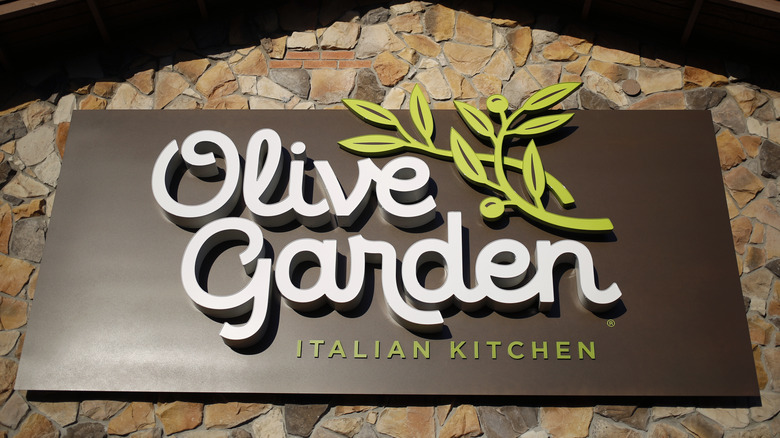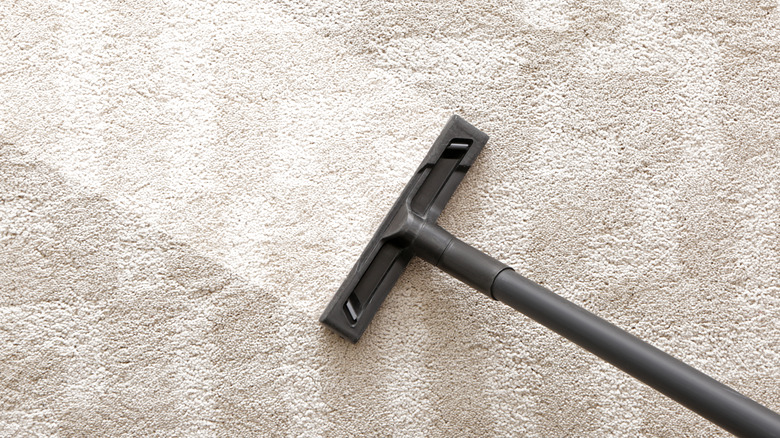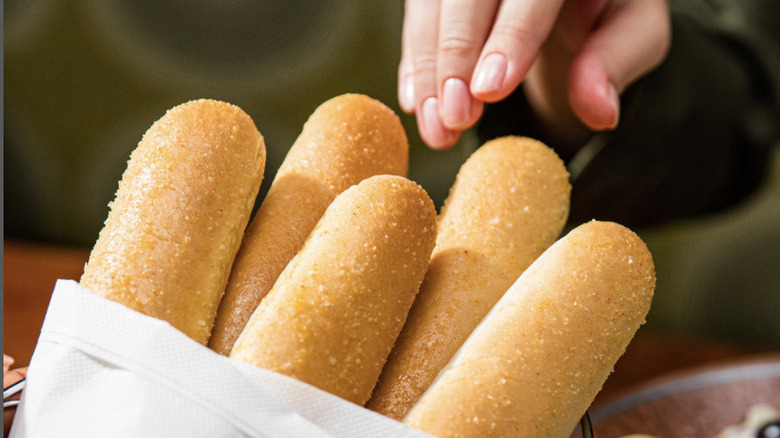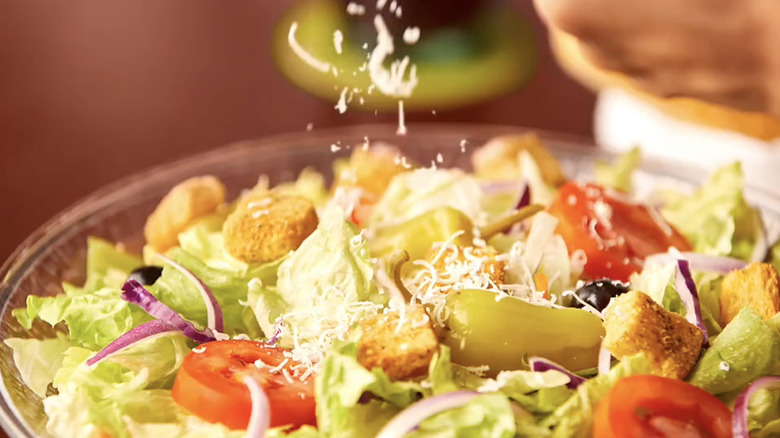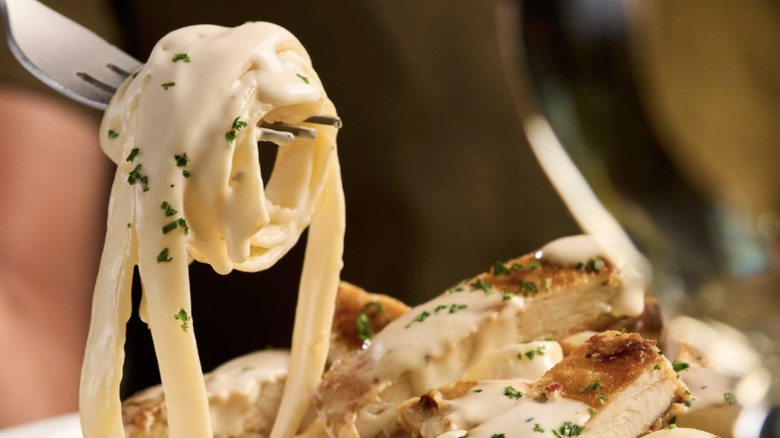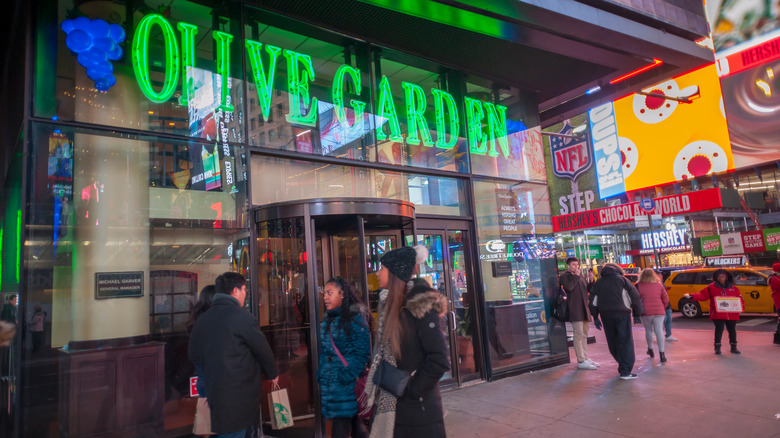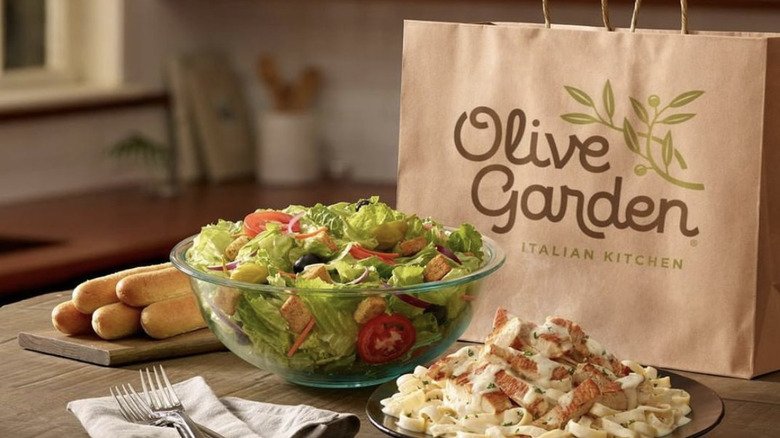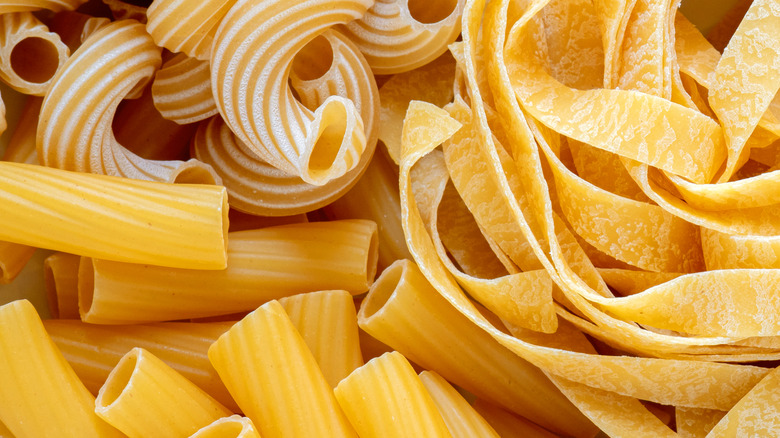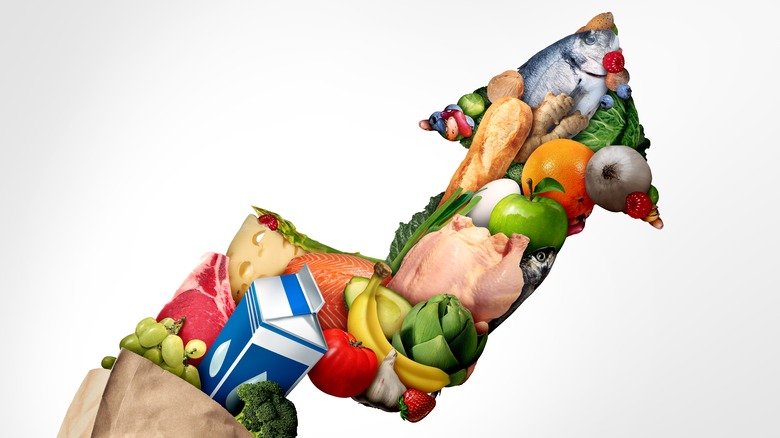We Finally Know Why Olive Garden Is So Cheap
Who among us doesn't love a free, warm, straight from the oven breadstick or a bowl of pasta that seemingly never ends? That kind of homecooked, comfort food is exactly what has made Olive Garden the successful chain it is today. Sure, it's not exactly "authentic" Italian, but there's a reason it's become an iconic part of American culture, even warranting its own "Saturday Night Live" parody.
The Tuscan-themed chain really does seem to succeed at making its customers feel like family, and keeping prices family-friendly is part of their appeal. Plus, with their extensive menu, serving everything from pasta, steak, soups, salads, and whatever a stuffed ziti fritta is, there really is something for everyone at the Olive Garden. So how does Olive Garden manage to serve never-ending pasta bowls to customers at over 875 locations without charging an arm and a leg? Read on to find out! (Spoiler alert: those never ending bowls might actually have an expiration date.)
Olive Garden is cleaning the carpets in restaurants less often
Providing diners with never-ending bowls of pasta and endless breadsticks comes at a cost, and so Olive Garden's parent company Darden Restaurants has had to find some, shall we say, creative ways to cut costs without driving up prices. One solution? According to Darden CEO Gene Lee, they're cutting back on how often they clean the carpets. "There's a protocol that you clean carpets once a month. If you do it more than that, you end up actually destroying the carpet and really not a whole lot of benefit there," Lee explained to ABC News.
Now, this might sound like they're cutting a pretty important corner here, but don't go calling the local health department just yet. Darden spokesperson Ron Defeo did clarify, "The restaurants are continuously cleaned and vacuumed throughout each and every day." But if you want a restaurant that gets a twice-monthly steam cleaning, then you might have to get your BOGO chicken alfredo somewhere else.
Olive Garden pays lower wages and relies on gratuities to keep employees well-paid
Olive Garden's parent company Darden Restaurants announced that they plan to raise the minimum wage across all their restaurants to $12 an hour starting in January of 2022 (via Nation's Restaurant News). This includes employees like hostesses, busboys, and servers who also earn gratuities. Darden expects that with this pay raise, their entry-level employees will earn an average of around $20 an hour. In other words, Olive Garden hopes to cut costs by paying their employees a lower wage and allowing the customers to fill in the gaps by (hopefully) tipping well.
This isn't unique in the restaurant industry, although the practice of tipping has come under fire in the last few years, with many claiming that tipping can be an unfair and discriminatory practice. For example, preliminary research has shown that people tip white servers better than Black servers. Wages garnished by tips also means workers can't really rely on a steady income. Even Darden CEO Gene Lee admitted that their employees' wages can vary widely because tips vary depending on where you live. According to Lee, "Starting wages or wage rates vary very, very much depending on geography and overall demand. We have people that ... make $25 to $28 an hour in the back of the house. And in some parts of the country, you're doing that same job for $18 an hour, depending on the environment."
Olive Garden had to rethink its unlimited breadsticks deal
Back in 2014, one of Darden's chief investors, the hedge fund Starboard Value created a slideshow outlining all of the ways they want Olive Garden's parent company to cut costs. One of their main issues was Olive Garden's famous unlimited breadsticks, which Starboard claims had worsened in quality and likened them to "hot dog buns." Starboard argued that the signature breadsticks were also a huge source of food waste and estimated they'd save roughly $5 million a year by changing this Olive Garden staple.
But before you get all worked up about The Man coming for your breadsticks, the plan wasn't to ax them, it was to rethink how they are served. According to Starboard, since most customers don't eat all of the breadsticks, and they apparently get stale after about seven minutes sitting on the table, they argued that they'd save a lot of wasted carbs by implementing a plan to serve one breadstick per customer at the table, plus one extra. Of course, if customers want more they can ask for them, and this ensures not only that diners get fresh, warm breadsticks, but that they waste less food and save money, which should mean lower prices for consumers.
Those never ending dishes might be coming to an end
The breadsticks weren't the only thing Olive Garden investors took issue with. Starboard Value pointed out that Olive Garden's signature endless salads were also contributing to food waste and profit loss since servers were often bringing over-dressed, giant salads to the table in an effort to reduce the number of times they went to and from the kitchen to fetch more salad. The result? A lot of salad in the trash.
The same could be said of Olive Garden's Never Ending Pasta Bowl promotion. Incoming Darden CEO Rick Cardenas told investors that the promotion, which they haven't offered since 2019, might be done for good. It's understandable that offering customers unlimited bowls of pasta, as well as unlimited breadsticks and unlimited salad or soup for $10.99 wasn't exactly making them money. And while you might be sad that something billed as "never ending" has in fact ended, remember that as long as Olive Garden can keep their prices low, you can always spring for a second entree. Think of it as a DIY never-ending pasta promotion!
The chain has simplified to cut back on waste
Unlimited breadsticks, pasta, and salad are just some of the food waste issues that Starboard Value argued were contributing to increased food costs at Olive Garden. They also posited that Olive Garden's very long, diverse, and not always truly authentic Italian menu was contributing to excessive levels of food waste as well. While variety is one of the things people love about Olive Garden, too much of a good thing can be bad. The extensive menu was creating inefficiencies and more errors in the kitchen, as well as longer ordering times and confusion amongst customers. Basically, when there's too much variety, it's hard to maintain quality.
Starboard Value also went so far as to say Olive Garden's biblically lengthed menu, "presents a cheap diner image and signals to the customer that 'we do everything, but nothing well.'" But this poses a real pickle for a chain that is known for offering customers lots of options. Darden CEO Gene Lee summed it up this way: "How do we continue to simplify our menu offerings and maintain our high variety ratings?" It's a tough predicament, but one that Olive Garden seems to have solved.
A large customer base helps Olive Garden keep prices low
Another way that a national chain like Olive Garden is able to keep their prices so competitively low is because they have a ton of customers. As of 2021, there are 875 Olive Garden restaurants in the United States. In a time when many restaurants aren't doing too well, Olive Garden's devoted customer base has the brand thriving. In fact, Olive Garden, alongside LongHorn Steakhouse, are Darden's biggest restaurant chains (via Business Insider). They even spread their breadstick gospel to Latin America, with 57 restaurants spanning across Brazil, Colombia, the Dominican Republic, and Panama.
And despite some reports that millennials were killing the casual fast-dining restaurant, Darden's CEO Gene Lee has made it clear that is not the case. According to Lee, "I know you all don't think millennials go to casual dining restaurants, but 30% of all our guests are millennials." While millennials get blamed for a lot of things, driving up Olive Garden prices cannot be one of them. Turns out millennials do eat things other than avocado toast!
Take out is big business with Olive Garden
Unlike a lot of restaurants during the last two years, Olive Garden was seeing record profits as of 2021. So how did they manage to not only survive a pandemic that shuttered so many eateries, but actually thrive? The secret: take out. Olive Garden was already set up to provide take-out before the pandemic so that wasn't a massive business model shift. But even more importantly, they didn't ever use third-party delivery apps like DoorDash, PostMates, or Uber Eats, which famously take a very large commission from restaurants that use their services to reach more customers. To put it simply: that convenience comes at a huge cost.
As Darden Restaurants CEO Gene Lee put it, Olive Garden wasn't interested in, "participating in giving away our food through third-party channels." As Lee pointed out, a lot of restaurants are shifting those third-party costs onto their customers by raising food prices. And since they have such a devoted customer base, Olive Garden is finding that people are willing to make the trek to pick up their food, even if it's less convenient than delivery. And hey, doing take-out is still a lot easier than finding a Nonna to make you some pasta. Or cooking for yourself! *shudder*
Cheaper ingredients help keep prices low
Part of Olive Garden's appeal is that you can get a big, comforting, filling meal for not a lot of money. And that is partly because their chief ingredient is pasta, which has lined the pantries of many a broke college student for a reason: it's really cheap. That means Olive Garden doesn't have to charge an arm and a leg to turn a huge profit on an entree like fettuccine alfredo. An entire pound of fettuccine costs roughly $1.50, and the other main ingredients are parmesan cheese, which you can buy a whole tub of for less than three dollars, some heavy cream, butter, an egg, and seasoning. For around ten dollars, you could make your own fettuccine alfredo to feed an entire family.
Considering Olive Garden charges roughly $15 for the same dish (it varies slightly based on location), it's easy to see how they make a huge profit off these very basic ingredients. Same goes for the breadsticks, which are also made from basic ingredients you probably have at home. The more profit they make, the lower your prices remain. And that's capitalism, baby!
Prices may have to rise in the end
If you've opened Zillow or tried to rent a car over the last year, you know that costs are rising ... pretty much everywhere. And unfortunately, the same can soon be said for your beloved breadsticks and chicken picatta. Despite all the things Olive Garden has done to keep costs down over the years, it looks like prices are still going to be going up, albeit slightly. Thanks to inflation causing a 9% increase in food and beverage costs over this last quarter, Olive Garden's parent company Darden announced that they'll have to raise prices by 4%.
Considering they also saw a 9% increase in worker wages over the last quarter, it's understandable that food prices are rising. As businesses and the economy recover from the pandemic, Olive Garden isn't the only restaurant being impacted by inflation. Still, Olive Garden's parent company is hoping that the slight increase won't deter customers too much. And to be fair, it'll probably be the skyrocketing cost of gasoline that keeps people home.
